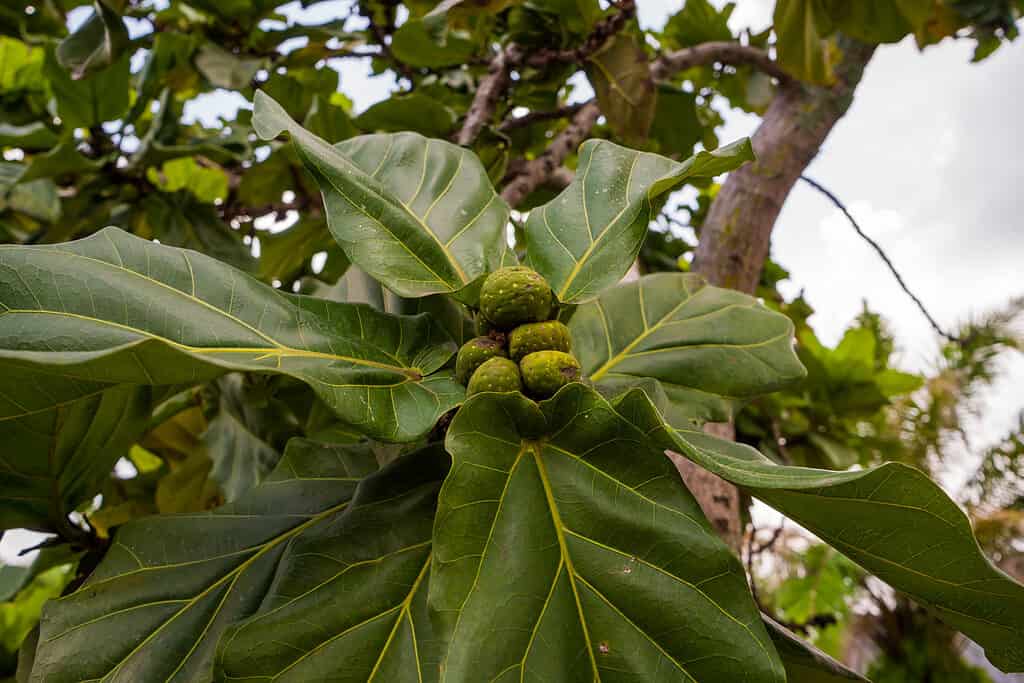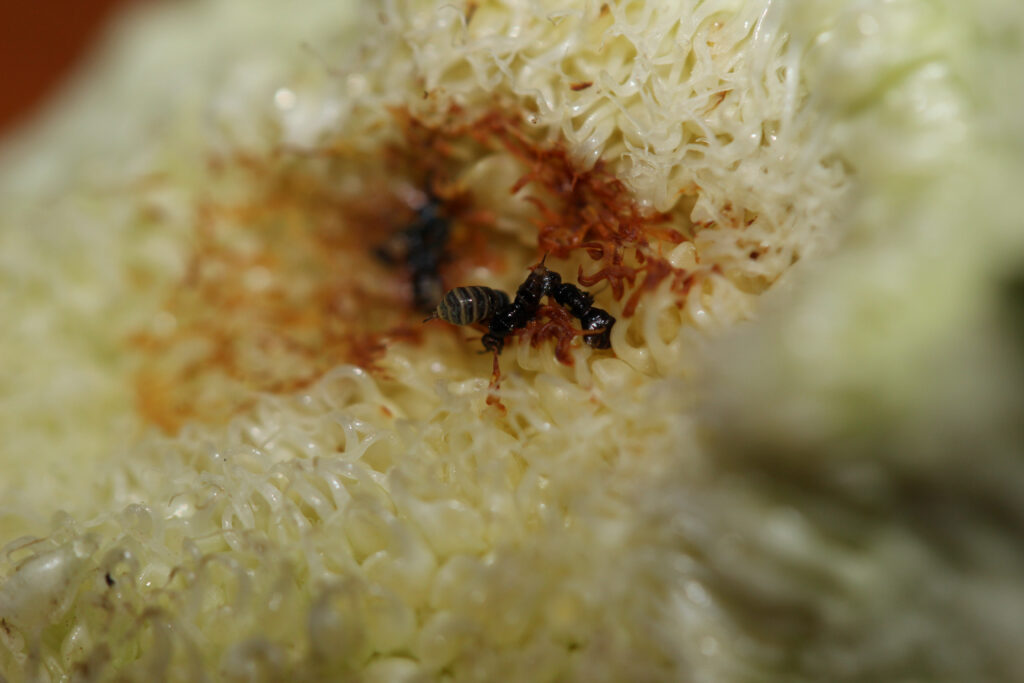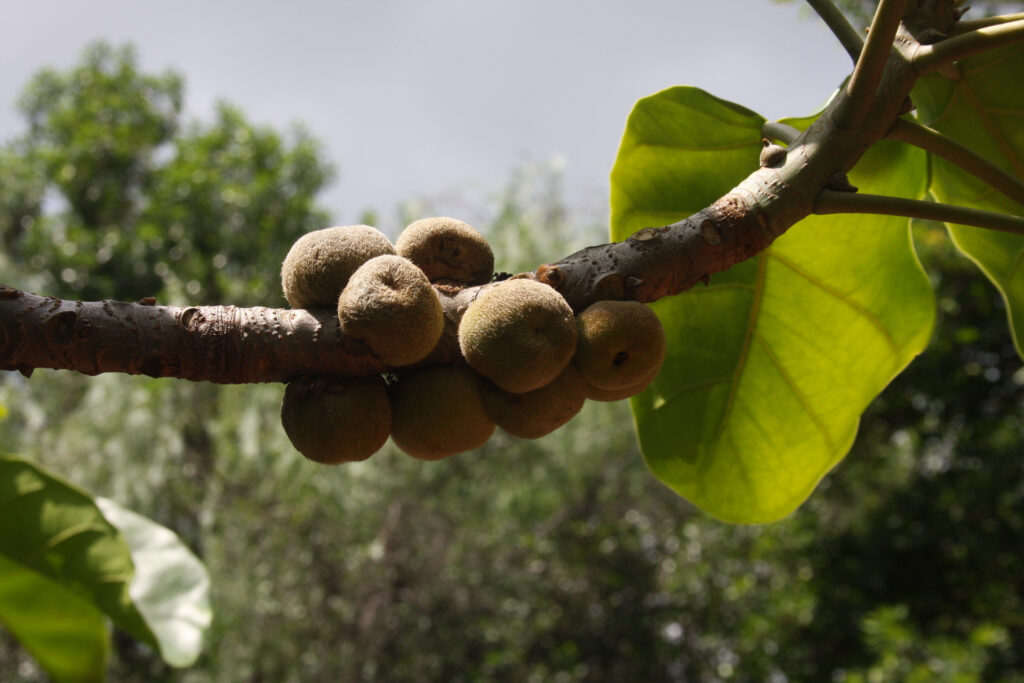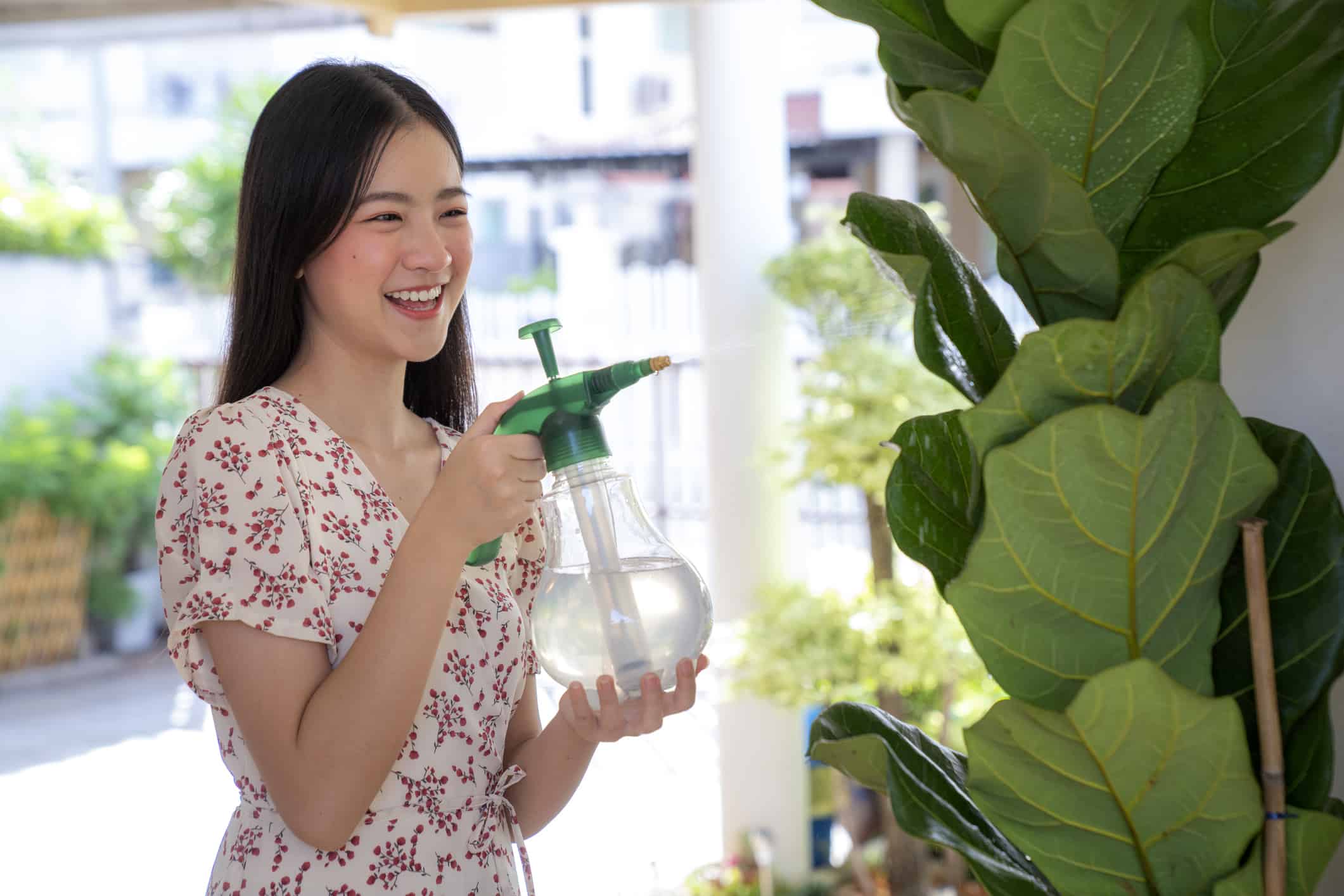Fiddle leaf figs (Ficus lyrata) are native to tropical Africa and get their name from their large violin-shaped leaves. They are very popular houseplants and will grow in a hot zone garden, but do they actually produce succulent figs? Do fiddle-leaf fig plants even produce fruit at all? Let’s find out.
Do Fiddle Leaf Figs Plant Produce Figs?
Fiddle leaf fig plants belong to the fig (Ficus) genus, and they produce fruit, as you would assume from the name. However, it rarely occurs anywhere outside their native tropical African habitat for a number of reasons that we’ll look at below.
If you want to grow edible figs, you are better off choosing the common fig tree (Ficus carica) because fiddle-leaf figs are primarily grown for their luscious green foliage.

Fiddle leaf fig plants belong to the fig (
Ficus) genus, and they produce fruit as you would assume from the name.
©Fajar Tri Amboro/Shutterstock.com
Why Isn’t My Fiddle Leaf Fig Producing Fruit?
There are several reasons why a fiddle leaf fig stubbornly refuses to produce any fruit or even flowers outside its native rainforest environment.
Light Requirements
Fiddlers need lots of bright but indirect light to stay healthy and even more to bear fruit. Indoors, there just isn’t enough light to stimulate fruit production, even if you place it near a window. It just doesn’t compare to the African sun.
Low Humidity
In lowland rainforests, humidity is very high, and it’s nearly impossible to achieve this moisture level for a houseplant or even an outdoor fiddle leaf fig.
Very Specific Pollination!
Fiddle leaf figs rely on a fig wasp to pollinate them, and they aren’t found in many places other than a fiddler’s native tropical habitat. A pollinating wasp does more than just walk over the flowers. It actually burrows into the fruit! It’s an example of co-evolution, and you can read all about it in this article from the Ecology and Evolution journal.
Another pollination issue is that fiddlers are dioecious, which means they are either male or female. For pollination to occur, both a male and female plant need to be close. In contrast, common fig trees are monoecious, so they produce both male and female flowers on the same plant.
Without pollination, fiddle leaf figs won’t fruit.

A pollinating wasp does more than just walk over the flowers. It actually burrows into the fruit!
©Nic Pasquini/Shutterstock.com
Are Fiddle Leaf Fig Fruits Edible?
Yes, fiddle leaf fig fruits are edible, but here’s the issue. They don’t taste good, so even if you did spend hours and dollars trying to make your fiddle leaf fig bear fruit, the end result would be a disappointment.
Fiddle leaf fig fruits don’t taste like delicious figs you can pick up in the store or grow in your yard. Even though they’re not toxic, their skin is leathery; the flesh is mouth-drying, quite bitter, and, more often than not, entirely bland.
This is why fiddle leaf figs are usually grown as ornamentals for their exotic paddle-shaped leaves.

Fiddle leaf fig fruits are edible, but here’s the issue. They don’t taste good.
©Bettina Calder/Shutterstock.com
What Do Fiddle Leaf Figs Fruits Look Like?
Fiddle leaf fig fruits are rounded green figs borne where the stems and branches meet. They often grow in twos or threes. Inside, they look like a typical fig, full of seeds with little flesh.
Will My Fiddle Leaf Fig Produce Flowers?
Indoor fiddlers won’t produce flowers due to insufficient light and humidity, but outdoor fiddlers in tropical areas may flower in the summer months. Don’t expect beautiful blooms even though its leaves are truly gorgeous! A fiddle leaf fig flower blooms inside a hollow receptacle that grows to form a fruit if it’s pollinated. Most horticulturists describe fiddle leaf fig flowers as ‘insignificant.’
How to Make a Fiddle Leaf Fig Plant Produce Fruit
It’s very difficult to make a fiddle leaf fig fruit outside its native environment, even if you live in USDA growing zones 9-11. Plus, even if you do manage it, the fig won’t taste good!
However, if you live in a tropical, humid area with lots of light and pollinating fig wasps, then your fiddler may produce figs.
Make sure the fiddler has enough water, fertilizer, light, and shelter from the wind. Bear in mind both male and female plants in the same vicinity are required for pollination.
They won’t taste good, but you’ll have bragging rights among fiddler aficionados.
5 Tips to Help Grow Healthy Fiddle Leaf Fig Plants
How to Water a Fiddle Leaf Fig
Watering a fiddle leaf fig is simple once you’ve got to grips with a good regime. A houseplant fiddler needs water when the soil is dry down to an inch. Push a finger into the soil. If it’s still damp, hold off watering it and wait another few days before testing it again. If it’s dry, here is how to water it.
Put a small fiddle leaf fig in a sink or bucket of water so it can soak up the liquid it needs. Allow it to drain before replacing it in the display pot.
Large fiddlers should be given a cup of water. Add another cup until water runs from the base. Then, let the top soil dry out before watering it again.
Allowing a fiddler to partially dry out means air can reach its roots. Plants need air and water on their roots to survive. Testing soil before watering also makes sure its roots don’t rot in a consistently moist potting mix.

Misting fiddle leaf fig plant,
Ficus lyrata, with a spray bottle.
©iStock.com/NeoPhoto
Mist It!
In its tropical rainforest habitat, a fiddler is often drenched in humidity. To replicate this, mist its amazing leaves every few days. Not only does this increase humidity levels, but it also helps keep foliage dust-free so it can photosynthesize efficiently and grow taller.
Light Requirements for an Indoor Fiddle Leaf Fig
Fiddlers receive lots of bright African sun in their native environment, but this is shaded by tall rainforest trees. To get the best from your fiddler, put it in a bright place, but make sure no direct sunlight falls on its foliage. Windowpane-magnified sunlight will burn its foliage and cause leaf scorch which is unattractive and gives disease a place to take hold. It’s not reversible either, so it’s best avoided in the first instance.
Rotate the plant a quarter turn each week to ensure even light distribution to all the foliage because this prevents lean and one-sided bushy growth.
Fertilizer
A happy fiddle leaf fig puts on a foot of growth each year in summer, topping out at ten feet indoors. This means it needs plenty of nutrients! Give a fiddle leaf fig regular weak houseplant fertilizer in the growing season, but be sure to follow instructions because too much fertilizer will poison it.
Growing a Fiddle Leaf Fig Outdoors
Fiddle leaf figs are popular houseplants in temperate zones, but they will also grow outdoors in USDA zones 9-11 and other tropical to subtropical countries. In other USDA zones and northern Europe, fiddlers can make the most of summer sunshine but must return indoors to survive cold winters.
In tropical areas, fiddle leaf figs can be planted straight in the ground. They like lots of rich organic matter and plenty of water in drought conditions. Shelter from prevailing wind is also important, but the shelter mustn’t block out sunlight.
One really helpful tip is to acclimatize a fiddle leaf fig before planting it outdoors. Do this by exposing it to an extra hour of sunlight every few days until it’s receiving a day’s worth of sun.
This is important because fiddlers are usually grown under artificial lights, so when they’re planted outside, they just aren’t tough enough to cope.
Recap: Do Fiddle Leaf Fig Plants Produce Fruit?
Let’s recap on whether a fiddle leaf fig plant will produce fruit!
Fiddlers produce small, unappetizing figs in their native rainforest habitats, but indoors, they won’t fruit. It’s because they don’t receive enough light or humidity, and there are no specialist pollinating wasps in our houses.
Outdoors, in a tropical zone, a fiddler might flower and fruit, but you’ll need lots of light, shelter, humidity, pollinating fig wasps, and both male and female fiddlers to make it work.
In general, people buy fiddle leaf figs for their handsome green foliage.
The photo featured at the top of this post is © TY Lim/Shutterstock.com
Thank you for reading! Have some feedback for us? Contact the AZ Animals editorial team.






